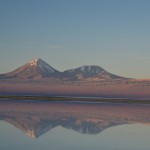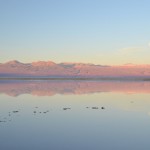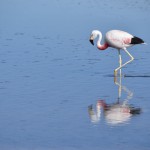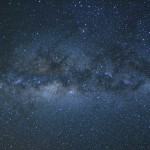We spent three full days in San Pedro in the Atacama desert in Northern Chile. San Pedro is very small, and a bit of a tourist town, but in a completely different way than for example Cartagena: the tourists congregating in San Pedro are all of the backpacker / outdoor adventurer type (90% of people you met were wearing hiking boots). San Pedro is in the middle of the Atacama desert, the most arid desert in the world (5 days of rain per year!) and has many natural sights and outdoor activities within driving distance. It is also close to the Bolivian border and hop-off point for tours of the Salar de Uyuni. With its location in the desert and an elevation of roughly 2500m above sea level, it got very cold there at night – so for the first time on the trip we brought out the multiple layers including down jackets we had managed to squeeze into our carry-on size luggage.
We did multiple tours to the surrounding highlands and lakes in our time there. On one day, we went to the Laguna Cejar. This lagoon, in the middle of the Salar (=salt flats) de Atacama is so salty that you can float. Going into the water was quite an interesting experience – not just because of the floating but also because of the temperature. In the day time the sun is quite strong so it wasn’t too cold outside the water (maybe around 20 degrees, but feeling warmer in the sun). The water, however, was definitely quite chilly. What we realized after a while though, was that once you held still and let your body sink down a little more, the water about 20cm below the surface was actually much warmer! At first we were quite puzzled by this, since it seemed inconsistent with basic physics. However, then we figured that in the extremely dry air the water on the surface must just constantly be evaporating and cooling down the top layer of the water.
Another day, we did a long tour to the altiplanic lagoons and the pieras rojas (red rocks). Many of these lagoons were at least partly frozen over, since at more than 4000m it was very cold. It his hard to describe the beauty of these lagoons, with the hills, mountains and volcanoes around reflecting in the still water, or flamingoes walking awkwardly through the lagoon, so I will share some pictures to give a better impression.
The last activity that we did was stargazing. With the dry, cloudless air, and absence of light pollution, the Atacama desert is perfect for observing the night skies. The Milky Way is visible even from the streets of San Pedro, and much better once you go out of town. In fact, the biggest astronomical observatories of the world are located in the highlands close to San Pedro due to the great climate conditions and high altitude. The stargazing tour we did was amazing. We were taken by bus to a small place outside of town at around 9pm when the sun had set for a while. Out there, our group of maybe 20 people was first given an short introductory talk to what was visible in the sky (lots of oohs and wash during the talk since there were so many shooting stars), and then we were shown to a group of telescopes with which various things could be looked at: Jupiter, with four of its moons very visible in the telescope, Saturn, with the rings clearly visible, and many other things including star clusters, nebulae, etc. Those of us who had brought good digital cameras were also given a brief introduction of how to take good pictures of the sky, and we did capture some good ones I will share. It was really amazing – I have definitely never had such a good view of the night sky before.
Our last day in San Pedro we spent mostly getting organized for our your across the border to Bolivia and into the Salar de Uyuni – more details on that in my next post.
Some pictures follow.
- Dos Ojos (one of the two)
- Laguna Tebinquinche
- Laguna Tebinquinche
- Pieras Rojas
- Flamingo
- Stargazing





